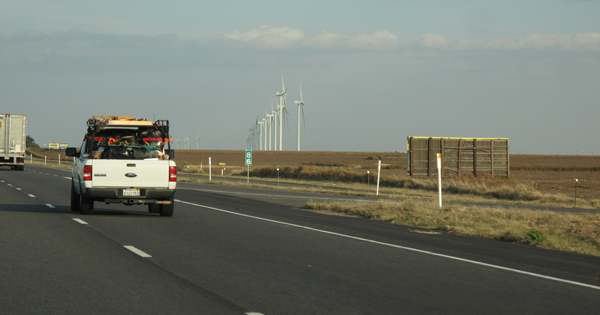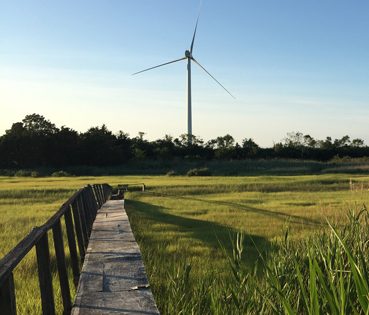


What will the neighbors say about a wind turbine?
Photo by Tammy Beeson February 07, 2018
National survey shows developer transparency is key to perceived fairness in project planning and picking sites
More than 1.3 million homes across the United States are located within five miles of a large wind turbine. Yet, little is known about how wind turbine projects affect nearby homeowners or how these neighbors feel about them.
The University of Delaware’s Jeremy Firestone is part of an international team, led by the U.S. Department of Energy’s Lawrence Berkeley National Laboratory (Berkeley Lab), which is focused on gaining a greater perspective on this issue. The group conducted the first national survey on public perceptions of individuals living near land-based wind power projects.
The 2016 survey collected data from 1,705 randomly selected individuals within five miles of 600 wind power projects across the country. Results are based on phone, mail and internet responses to more than 50 questions.
Firestone, who directs UD’s Center for Carbon Free Power Integration (CCPI) and is a professor in the School of Marine Science and Policy, is a leading expert in wind power research, teaching and policy. His work on the project focused on understanding fairness of the process and its relationship to whether people develop positive or negative attitudes about land-based wind projects. The work was done in collaboration with researchers from Berkeley Lab, Martin-Luther University of Halle-Wittenberg and the Medical School of Hamburg in Germany; RSG Incorporated, an independent consultancy group in Vermont; Portland State University and the National Renewable Energy Laboratory.
Developer transparency influences perceptions of fairness
Study participants were asked a series of questions about participation in, and perceived fairness of, the wind power project’s planning and siting process. The survey revealed that roughly 71 percent of respondents who were aware of their local planning process for the wind project, and had an opinion, perceived it as having been largely “fair.”

The study findings also showed a strong relationship between the transparency of the developer and community feelings of fairness.
Firestone noted that developer transparency and a community having had influence in things like project layout and design were strong predictors of a more positive attitude, even when controlling for factors such as aesthetics, landscape and wind turbine sound considerations.
The effect of these variables, when combined with general perceptions of fairness, form the most important determinant of having a positive attitude.
“If there is some give and take on the number and location of wind turbines, you will end up with happier communities where people feel they had a legitimate voice in the process,” Firestone said.
The researchers collected data on the kinds of activities respondents engaged in related to the process, such as whether they attended a meeting, spoke at a meeting, put up a sign, wrote someone or posted something on the Internet. Of those who were aware of the project, roughly a quarter took action. Most attended a meeting.
However, Firestone pointed out that while open meetings are indisputably important, they do not appear to be generally reflective of wider community sentiment.
“Oppositional sentiments are as likely to be heard at meetings as supportive ones despite that those who were aware of their local project prior to its construction and who had positive attitudes outnumbered those who had negative attitudes by approximately 6 to 1,” Firestone said.
Statistical results were weighted to correct for known demographic discrepancies. The researchers also controlled for whether respondents had a wind project on their property or received compensation.
Wind energy developers as ambassadors
While a 2016 study by Pew Research Center found a large majority of Americans (83 percent) favor wind power as a renewable energy source, Ben Hoen, a Berkeley Lab research scientist, stated that “the findings here are notable in that they are limited to perceptions of individuals who live in close proximity to wind turbines. Moreover, Dr. Firestone carefully tailored his analysis to the portion of the respondents that moved in before construction of their local project commenced. This subset of opinions is key to understanding potent drivers of perceived fairness of the planning process.”
The survey results suggest that jurisdictions should consider developing procedures to ensure citizens are consulted and heard, as well as institute benchmarks or best practices for developer interaction with communities and citizens.
According to Firestone, the findings provide an important touchstone that can inform developers and regulators about the important role they play in how a community and its residents perceive wind project.
“Given the price drops of renewable energy projects over the last few years, I expect we will see more land-based wind and commercial solar projects,” Firestone said. “If developers want to continue building projects then it is important to be sensitive to these issues.”
The research team reported their findings in a paper, titled “Reconsidering barriers to Wind Power Projects: Community Engagement, Developer Transparency and Place,” published in the Journal of Environmental Policy and Planning. It is the second of a planned five distinct research papers informed by the results of the broader Berkeley Lab study.
Co-authors on the paper include Hoen and Joseph Rand at Lawrence Berkeley National Laboratory; Debi Elliott, director of the Survey Research Lab at Portland State University; and Gundula Hübner (professor) and Johannes Pol from Martin-Luther-Universität Halle-Wittenberg in Germany.
Firestone will discuss the various predictors of planning process fairness and their influence on attitudes toward land-based wind projects in a webinar on Feb. 13 at 1 p.m. Eastern time. The webinar is free, but registration is required.
Contact Us
Have a UDaily story idea?
Contact us at ocm@udel.edu
Members of the press
Contact us at 302-831-NEWS or visit the Media Relations website

